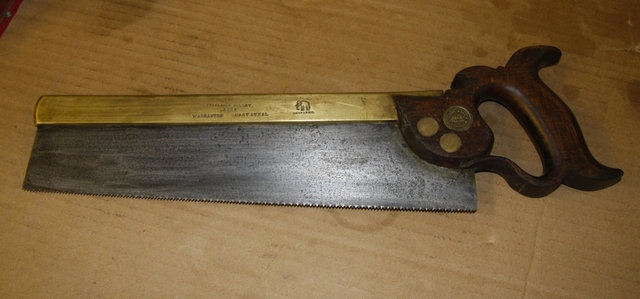condeesteso
Established Member
I thought this may be of interest, a recent acquisition:

It's 14", 12 tpi, and was surprisingly quite sharp when it arrived. Elsewhere Mignal mentions he has one, and comments on the weight. This one is a shade under a kilo, say 2lb. For comparison here it is alongside the Two Lawyers carcass saw (12" 14tpi) which weighs approx 400g:

I know the Turners saws covered quite a long period but I'm not sure when from. I have an ad dated 1947 with Tyzack apologising for shortage of stock and promising availability soon. And Cheshire got 2 new saws as late as the 80s.
The markings are Sheffield Cast Steel; W. Tyzack Sons & Turner Nonpareil + logo. The main screw motif is Trade Mark Nonpareil.

Just out of interest, anyone good at dating these??
I'm sure it's a very good saw, handles nicely once I get used to the weight, tracks very well - could do with getting really sharp.
Pedder knows his saws, and I note his own blog (Old Ladies) features a saw very like mine as the masthead:

I noted Swagman (new dt backsaw) mentioning the naming of saws (sash, carcass etc) - a bit like planes maybe, the name gives a guide to what to expect but shouldn't limit your idea of what it might be used for. Someone here once said a No3 (plane) is a jointer if you make boxes all day. I have at least one jack tuned as a smoother... enough about planes.
I'll keep an eye out for more Tyzack & Turner - impressed with this one. It's a maker on my list along with early S&J (probably broadly underrated I suspect).
Any more Tyzack & Turner out there - show'n'tell.
p.s. re Cast Steel, How, why? I'm no sawmaker but I would have hot rolled it, anneal maybe, surface grind and heat treat. Don't think that casting would have crossed my mind. I guess it is the steel source, a bit like Record's crucible cast steel irons.

It's 14", 12 tpi, and was surprisingly quite sharp when it arrived. Elsewhere Mignal mentions he has one, and comments on the weight. This one is a shade under a kilo, say 2lb. For comparison here it is alongside the Two Lawyers carcass saw (12" 14tpi) which weighs approx 400g:

I know the Turners saws covered quite a long period but I'm not sure when from. I have an ad dated 1947 with Tyzack apologising for shortage of stock and promising availability soon. And Cheshire got 2 new saws as late as the 80s.
The markings are Sheffield Cast Steel; W. Tyzack Sons & Turner Nonpareil + logo. The main screw motif is Trade Mark Nonpareil.

Just out of interest, anyone good at dating these??
I'm sure it's a very good saw, handles nicely once I get used to the weight, tracks very well - could do with getting really sharp.
Pedder knows his saws, and I note his own blog (Old Ladies) features a saw very like mine as the masthead:

I noted Swagman (new dt backsaw) mentioning the naming of saws (sash, carcass etc) - a bit like planes maybe, the name gives a guide to what to expect but shouldn't limit your idea of what it might be used for. Someone here once said a No3 (plane) is a jointer if you make boxes all day. I have at least one jack tuned as a smoother... enough about planes.
I'll keep an eye out for more Tyzack & Turner - impressed with this one. It's a maker on my list along with early S&J (probably broadly underrated I suspect).
Any more Tyzack & Turner out there - show'n'tell.
p.s. re Cast Steel, How, why? I'm no sawmaker but I would have hot rolled it, anneal maybe, surface grind and heat treat. Don't think that casting would have crossed my mind. I guess it is the steel source, a bit like Record's crucible cast steel irons.






































